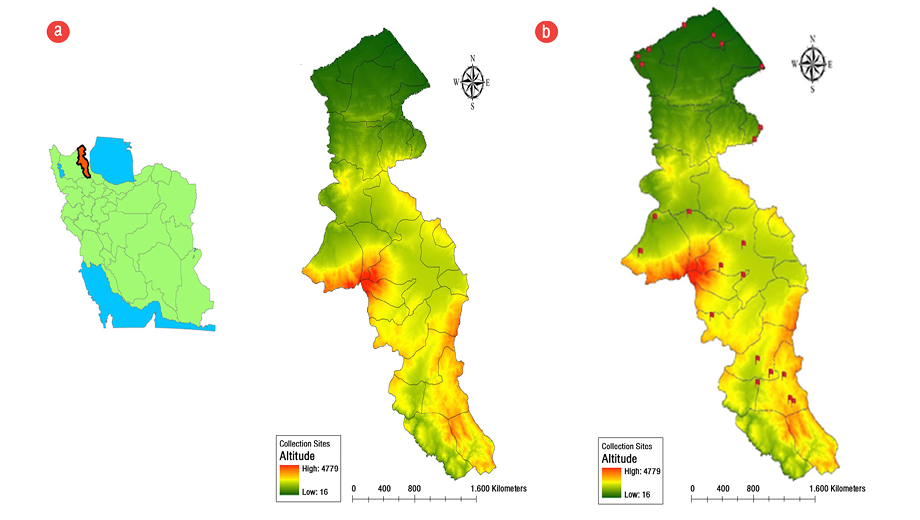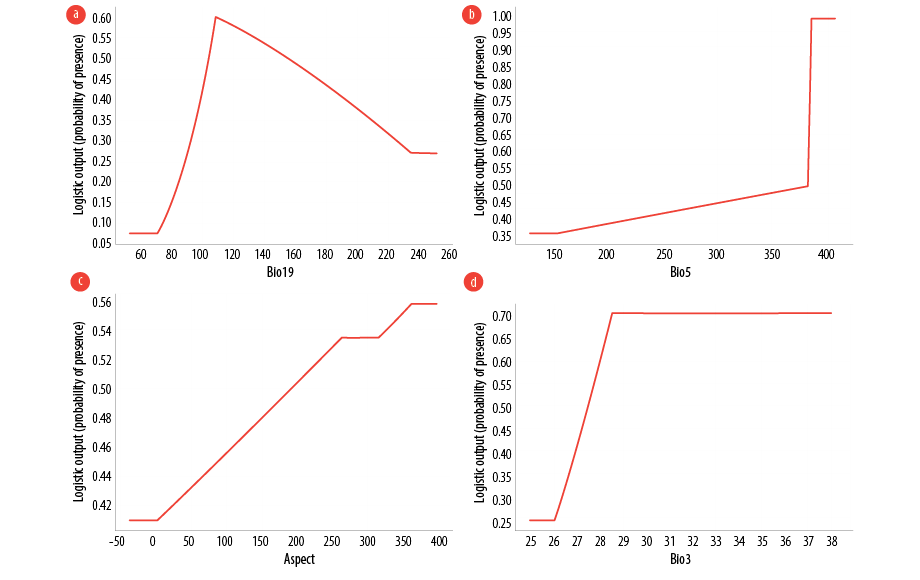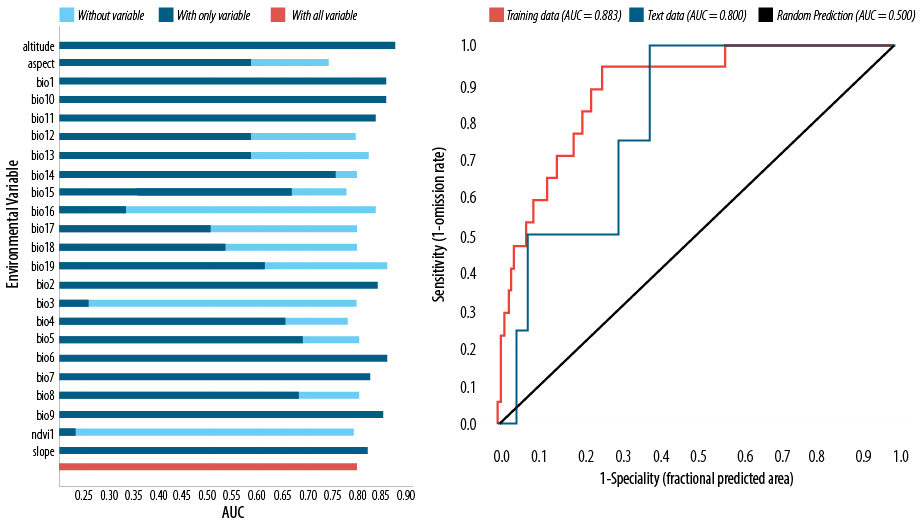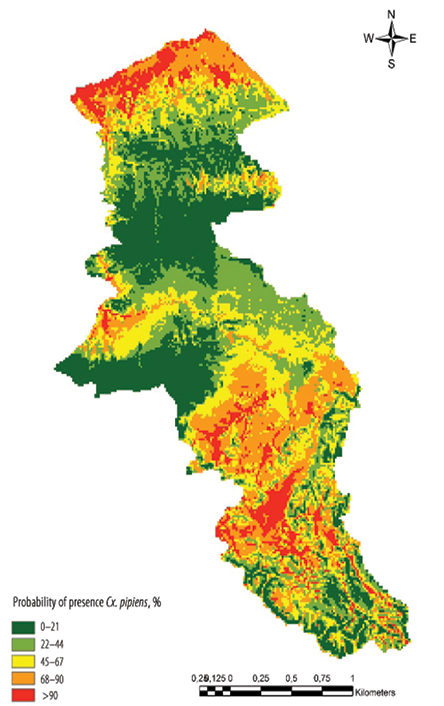Mosquito-borne diseases are one of the most important health problems in the world.1 At least 3531 species of mosquitoes (Culicidae, Diptera) including 112 genera have been reported in the world.2 Culex genus is classified into 26 subgenera and 769 species.3 Culex pipiens is distributed in tropical and subtropical regions such as Africa, Asia, Australia, and the tropical islands. In addition to human biting, they transmit numerous important diseases to humans. They include agents of parasitic diseases such as Wuchereria bancrofti, Brugia malayi, Brugia timori and the important viral disease agents such as West Nile virus (WNV), Sindbis virus, Japanese encephalitis, St. Louis, Western Horse Encephalitis, Rift Valley Fever (RVF), and Oropouche fever.4–6 WNV is the re-emerging pathogen which threatens human health.7 The agent of West Nile fever belongs to the genus Flavivirus transmitted by Culex mosquitoes.8 West Nile fever was reported for the first time in Uganda in 1937.9 In Iran, WNV has been reported in several regions, especially central, southwestern, and northern Iran,10 with the infection rate reported to be 1.3–5%.10–12 Many studies have been carried out on the distribution of mosquitoes, especially larvae and distribution of Culex genus adults or larvae in different parts of Iran.13–16 Various studies conducted on mosquitoes in the northwest of Iran, including Ardabil province have reported a high frequency of Culex species.17–19 Infection with WNV has not been reported in Ardabil province. However, Dirofilaria infection with Culex has been reported in this province.20 Determining the distribution of vectors based on the Ecological Niche Model (ENM) can serve as a guideline to understand the ecology and distribution of diseases. It also calls for accurate planning to control and prevent this disease, which has been implemented in high-risk areas.21 MaxEnt is one of the most important tools for determining the ENM of one or more species by using environmental data while predicting the probability of the presence of species in different places.22 Our study sought to predict the distribution of WNV vectors namely, Cx. pipiens larva, using ENM in Ardabil province in northwest of Iran.
Methods
Ardabil province is located at 38.2514N and 48.2973E in the northwest of Iran, sharing a common border with the Republic of Azerbaijan to the north. The province has an area of 17 953 square kilometers with 10 cities and a population of 1.27 million. About two-thirds of the province consists of mountainous areas with high altitude while the rest are flat areas. The northern region of the province (Moghan plain) has a low altitude and a relatively warm climate, with the central and southern regions having cold climates [Figure 1].

Figure 1: Sampling locations and detection sites for Culex pipiens in the study area, Ardabil province, northwest of Iran, 2017.
We randomly selected 46 locations to collect larvae, which occurred twice monthly during seasonal activity of mosquitoes. Larval sampling was carried out by the dipping method (350 mL dipper) from January to December 2017 with the samples captured from May to November. Sampling was carried out from different parts in each habitat, with 10 dipping loads in each habitat. The larvae were stored in a lactophenol solution, and after about a week they became transparent so that microscopic slides were made using a Faure’s medium. The third- and fourth-instar larvae were identified using the appropriate identification keys.23–27
For modeling and determining the ENM, WNV vectors were analyzed using MaxEnt 3.3 software. To predict the distribution of Cx. pipiens with a presence probability of more than 70%, the maps of 23 climatic and environmental factors were used, which were taken at a resolution of 30 m/s from the website (http://www.worldclim.org/bioclim.htm) and Modis satellite [Table 1]. In these maps, the areas with a high probability of this species were marked with red, and areas with low presence were identified with green. Jackknife and crew analysis were used in MaxEnt to investigate the effects of environmental and climatic variables on Culex species distribution and consideration of its ecological niche. This model can be used to evaluate the location of the samples’ breeding places and their frequency in one place. The best breeding place and habitat for the species can be determined by this model.28
Table 1: Variables used for MaxEnt modeling of Culex pipiens distribution in Ardabil province, northwest of Iran.
|
Bio1 |
Annual mean temperature (oC) |
0.0 |
|
Bio2 |
Mean diurnal range: mean of monthly (max temp–min temp) (oC) |
0.0 |
|
Bio3 |
Isothermality: (Bio2/Bio7 × 100) |
6.8 |
|
Bio4 |
Temperature seasonality (SD × 100) |
0.0 |
|
Bio5 |
Maximum temperature of the warmest month (oC) |
21.2 |
|
Bio6 |
Minimum temperature of the coldest month (oC) |
0.0 |
|
Bio7 |
Temperature annual range (Bio5–Bio6) (oC) |
3.2 |
|
Bio8 |
Mean temperature of wettest quarter (oC) |
2.1 |
|
Bio9 |
Mean temperature of driest quarter (oC) |
0.0 |
|
Bio10 |
Mean temperature of warmest quarter (oC) |
0.0 |
|
Bio11 |
Mean temperature of coldest quarter (oC) |
0.0 |
|
Bio12 |
Annual precipitation (mm) |
0.1 |
|
Bio13 |
Precipitation of wettest month (mm) |
1.7 |
|
Bio14 |
Precipitation of driest month (mm) |
0.0 |
|
Bio15 |
Precipitation seasonality (coefficient of variation) |
6.2 |
|
Bio16 |
Precipitation of wettest quarter (mm) |
7.0 |
|
Bio17 |
Precipitation of driest quarter (mm) |
0.0 |
|
Bio18 |
Precipitation of warmest quarter (mm) |
0.0 |
|
Bio19 |
Precipitation of coldest quarter (mm) |
21.9 |
|
Altitude |
Elevation from the sea level (Beiranvand R, #1) |
3.6 |
|
Slope |
Slope of the area (%) |
17.7 |
|
Aspect |
Direction of slope (degree) |
6.9 |
NDVI: normalized difference vegetation index.
Table 2: Composition and localities of the larvae of Culex mosquitoes collected in Ardabil province, northwest of Iran, 2017.
|
Cx. modestus |
8 |
0 |
0 |
12 |
14 |
6 |
0 |
2 |
8 |
0 |
50 |
|
Cx. hortensis |
19 |
7 |
4 |
14 |
26 |
12 |
0 |
16 |
12 |
8 |
118 |
|
Cx. pipiens |
79 |
72 |
0 |
231 |
381 |
236 |
36 |
9 |
217 |
18 |
1279 |
|
Cx.theileri |
49 |
5 |
41 |
37 |
57 |
16 |
0 |
18 |
68 |
10 |
301 |
|
Cx. perexiguus |
2 |
10 |
0 |
0 |
6 |
0 |
0 |
0 |
0 |
0 |
18 |
|
Cx. tritaeniorhynchus |
1 |
6 |
0 |
0 |
6 |
0 |
0 |
0 |
0 |
2 |
15 |
|
Cx. mimeticus |
0 |
0 |
0 |
0 |
6 |
2 |
0 |
0 |
0 |
0 |
8 |
Table 3: The larval habitat characteristics and occurrence percentages of different Culex mosquitoes larvae in Ardabil province, northwest of Iran, 2017.
|
Habitat status, % |
|
|
|
|
|
|
|
|
Permanent |
95.0 |
90.0 |
75.0 |
71.5 |
68.0 |
71.0 |
95.0 |
|
Temporary |
5.0 |
10.0 |
25.0 |
28.5 |
32.0 |
29.0 |
5.0 |
|
Water, % |
|
|
|
|
|
|
|
|
Stagnant |
18.0 |
27.0 |
33.0 |
30.0 |
14.0 |
15.5 |
15.0 |
|
Slow running |
82.0 |
73.0 |
67.0 |
70.0 |
86.0 |
84.5 |
85.0 |
|
Vegetation, % |
|
|
|
|
|
|
|
|
Without vegetation |
3.0 |
15.0 |
23.0 |
22.5 |
20.0 |
19.0 |
21.5 |
|
With vegetation |
97.0 |
85.0 |
77.0 |
76.5 |
80.0 |
81.0 |
78.5 |
|
Type of bed, % |
|
|
|
|
|
|
|
|
Clay |
15.0 |
30.0 |
45.0 |
47.0 |
43.0 |
44.0 |
70.0 |
|
Sand |
25.0 |
15.0 |
35.0 |
30.0 |
20.0 |
25.0 |
20.0 |
|
Water status |
|
|
|
|
|
|
|
|
Stone or cement, % |
60.0 |
55.0 |
15.0 |
23.0 |
37.0 |
31.0 |
10.0 |
|
Opaque |
12.0 |
2.0 |
10.0 |
5.0 |
25.0 |
30.0 |
80.0 |
|
Transparent |
88.0 |
98.0 |
90.0 |
95.0 |
75.0 |
70.0 |
20.0 |
|
Ligh status,% |
|
|
|
|
|
|
|
|
Sunny |
0.0 |
4.0 |
12.0 |
26.0 |
15.0 |
38.0 |
40.0 |
|
Shaded |
5.0 |
36.0 |
17.0 |
20.0 |
19.0 |
17.0 |
20.0 |
|
Semi-shade |
95.0 |
60.0 |
61.0 |
54.0 |
66.0 |
45.0 |
40.0 |
|
Habitat type, % |
|
|
|
|
|
|
|
|
Natural |
92.0 |
85.0 |
78.0 |
86.0 |
95.5 |
87.5 |
75.0 |

Figure 2: Result of important variables impact on ecological niche of Culex pipiens larvae in Ardabil province, northwest of Iran, 2017.

Figure 3: Result of jackknife test on variables importance for Cluex. pipiens larvae in Ardabil province, northwest of Iran, 2017.
Results
Out of 2000 collected larvae from 46 collection sites in Ardabil province [Figure 1a], 1789 (89.5%) were identified as Culex larvae. Seven species of Culex genus were collected from 22 location sites [Figure 1b] and identified as follows: Cx. pipiens (71.5%), Cx. modestus (2.8%), Cx. theileri (16.8%), Cx. hortensis (6.6%), Cx. perexiguus (1.0%), Cx. tritaeniorhynchus (0.8%), and Cx. mimeticus (0.4%). Cx. pipiens was collected with a high frequency in all the counties, especially in northern (21.3%) and southern parts (12.9%) of the province while Cx. mimeticus was collected with a low frequency in Ardabil and Parsabad counties [Table 2]. The maximum number of larvae of Culex mosquitoes was collected from Parsabad (27.2%), and the minimum was collected from Namin (2.0%) counties. More than 80% of the collected samples were from permanent habitats. The other physical characteristics of its breeding places, such as habitats with vegetation, stone or cement bed type, transparent water status, semi-shade, and natural habitat are listed in Table 3.
The ENM showed that the following factors had the greatest impact on the ecological niche of Cx. pipiens larvae: precipitation of coldest quarter (Bio19; 21.9%), maximum temperature of warmest month (Bio5; 21.2%), slope of the area (17.7%), precipitation of wettest quarter (7.0%), direction of slope (Aspect; 6.9%), and isothermality (Bio3; 6.8%) [Table 1 and Figure 2]. Whereas the jackknife test showed that the annual temperature range (Bio7) was the highest predictor of Cx. pipiens larvae in the north and south of Ardabil province. With the increase of rainfall (from 80 to 110 mm) and annual temperature ranges (increasing from 1.5 to 3.5 oC), the density of larvae in their habitats had also increased [Figure 3]. The results of the MaxEnt model indicated that the most ecologically suitable areas of Cx. pipiens larvae occurrence were identified in two hotspots in northern and southern Ardabil. The northern hotspot is the largest area comprising three counties of Parsabad, Garmi, and Bilehsavar. This area is located on the borderline of Iran and the Republic of Azerbaijan [Figure 4]. Moreover, the receiver operating characteristic/area under the curve (ROC/AUC) index for Cx. pipiens larvae in the ENM was 0.88.

Figure 4: Ecologically suitable areas for Cx. pipiens larvae occurrence in Ardabil province, northwest of Iran, 2017.
Discussion
Two large areas in the northwest Iran constitute a suitable habitat for Cx. pipiens larvae. Therefore, studies can be carried out to delve into the possible infection of WNV in mosquitoes and humans in this region. For the first time in the northwest of Iran, this study determined ENM for seven mosquitoes’ larvae, which can be extended to other vectors. Previous studies have determined the ENM for leishmania infantum in humans (the agent of visceral leishmaniasis in Iran) and its vectors.29,30 However, there is a dearth of studies on ENM for mosquito larvae. In one research in Chile, Cx. pipiens modeling predicted that shallow and transparent water comprised suitable habitats for larvae and temperature was reported to be among the most effective factors.31 Likewise, most of the larvae were collected from transparent water in this study. Studies of modeling niche ecology have been carried out mostly on adult mosquitoes. Annual temperature range, precipitation of coldest quarter, maximum temperature of warmest month, slope and precipitation of driest quarter were the most important factors influencing the distribution and density of Cx. pipiens larvae. In modeling for Cx. pipiens for adults in America, it was found that non-forest regions with low vegetation coverage are appropriate for this species.32 In Kenya, the results of modeling RVF vectors (Cx. quinquefasciatus, Cx. univitattus, Mansonia africana, and M. uniformis) using MaxEnt indicated that soil type, rainfall in dry seasons, seasonal rainfall, and isothermal process had the greatest impact on the vectors.33 There is a plethora of studies and modeling carried out on West Nile vectors in the world. In one study about the effect of climate change on WNV vectors in USA in 2013, it was found that the increase in seasonal temperature and rainfall affected the frequency of Cx. pipiens and Cx. Quinquefasciatus34 or in Florida, rain in warm and cold months of the year was reported to be the most important factor impacting Cx. nigripalpus and Cx. Quinquefasciatus.35 Of the numerous studies on fauna and ecological characteristics of the larvae habitat done in Iran, some have been carried out in western Iran and West Azarbaijan province. In these studies,14,36–38 the number of collected Cx. pipiens larvae was higher than other that of mosquito larvae like our findings, with the higher prevalence of Cx. pipiens larvae. However, in another study in the southeast of Iran,39 Cx. perexiguus was found in the greatest abundance. The results of this research and their comparison with other studies show that Culex mosquitoes are also distributed in different parts of Ardabil province, which are like other regions of Iran. These vectors can transmit diseases to humans if there is a WNV cycle in this area.
Conclusion
Culex mosquitoes as the WNV vectors have a diversity of species in the Southwest of Iran. In addition, two large areas were found as ecological niches of larvae of Cx. pipiens, which call for more studies on infection in adult Cx. pipiens and their hosts in these regions.
Disclosure
The authors declare no conflict of interest. This research was financially supported by the Ardabil University of Medical Sciences, Iran (project number: 9502).
Acknowledgements
The authors are grateful to the health staff of Ardabil Health Centers for helping in the field activities.
references
- 1. Hongoh V, Berrang-Ford L, Ogden NH, Lindsay R, Scott ME, Artsob H. A review of environmental determinants and risk factors for avian-associated mosquito arboviruses in Canada. Biodiversity 2009;10(2-3):83-91.
- 2. Harbach RE. Mosquito taxonomic inventory. [cited 2013 May 25]. Available from: http://mosquitotaxonomic-inventory.info.
- 3. Reinert JE. Revised list of abbreviations for genera and subgenera of Culicidae (Diptera) and notes on generic and subgeneric changes. J Am Mosq Control Assoc 2001 Mar;17(1):51-55.
- 4. Azari-Hamidian S. Larval habitat characteristics of mosquitoes of the genus Culex (Diptera: Culicidae) in Guilan Province, Iran. J Arthropod-Borne Dis 2007;1(1):9-20.
- 5. Vinogradova EB. Culex pipiens pipiens mosquitoes: taxonomy, distribution, ecology, physiology, genetics, applied importance and control. 2nd ed. Pensoft Publishers; 2000. p. 236-240.
- 6. Vinogradova EB. Ecophysiological and morphological variations in mosquitoes of the Culex pipiens complex (Diptera: Culicidae). Acta Soc Zool Bohem 2003;67:41-50.
- 7. Tapper ML. Emerging viral diseases and infectious disease risks. Haemophilia 2006 Mar;12(Suppl 1):3-7, discussion 26-28.
- 8. Murphy FA, Fauquet CM, Bishop DH, Ghabrial SA, Jarvis AW, Martelli GP, et al. D. Virus taxonomy: classification and nomenclature of viruses. Springer Science & Business Media; 2012. p. 125-132.
- 9. Smithburn K, Hughes T, Burke A, Paul J. A neurotropic virus isolated from the blood of a native of Uganda. American J Trop Med Hygiene 1940;s1-20(4):471-492.
- 10. Chinikar S, Javadi A, Ataei B, Shakeri H, Moradi M, Mostafavi E, et al. Detection of West Nile virus genome and specific antibodies in Iranian encephalitis patients. Epidemiol Infect 2012 Aug;140(8):1525-1529.
- 11. Chinikar S, Shah-Hosseini N, Mostafavi E, Moradi M, Khakifirouz S, Jalali T, et al. Seroprevalence of West Nile virus in Iran. Vector Borne Zoonotic Dis 2013 Aug;13(8):586-589.
- 12. Sharifi Z, Mahmoodian Shooshtari M, Talebian A. A study of West Nile virus infection in Iranian blood donors. Arch Iran Med 2010 Jan;13(1):1-4.
- 13. Azari Hamidian Sh, Jouafshani M, Moslem M, Rasaei A. Mosquito fauna and distribution of the genus Culex (Diptera: Culicidae) in Guilan province. J Pajouhesh-va-Sazandegi 2005;18(3):39-45.
- 14. Khoshdel-Nezamiha F, Vatandoost H, Azari-Hamidian S, Bavani MM, Dabiri F, Entezar-Mahdi R, et al. Fauna and larval habitats of mosquitoes (Diptera: Culicidae) of West Azerbaijan Province, northwestern Iran. J Arthropod Borne Dis 2014 Apr;8(2):163-173.
- 15. Nikookar Sh, Moosa-Kazemi Sh, Oshaghi M, Yaghoobi-Ershadi M, Vatandoost H, Kianinasab A. Species composition and diversity of mosquitoes in neka county, Mazandaran province, northern Iran. Iran J Arthropod Borne Dis 2010;4(2):26-34.
- 16. Omrani S, Azari-Hamidian S, Pour-Shahbazi G, Taghipour S. Fauna and the distribution of mosquitoes (Diptera: Culicidae) in Chahar Mahal and Bakhtiari province, 2011-2012. Shahrekord Univ Med Sci J 2015;16(6):127-138.
- 17. Abai M, Azari-Hamidian S, Ladonni H, Hakimi M, Mashhadi-Esmail K, Sheikhzadeh K, et al. Fauna and checklist of mosquitoes (Diptera: Culicidae) of East Azerbaijan Province, northwestern Iran. J Arthropod Borne Dis 2007;1(2):27-33.
- 18. Moradi-Asl E, Hazrati S, Vatandoost H, Emdadi D, Ghorbani E, Ghasemian A, et al. Fauna and larval habitat characteristics of mosquitoes (Diptera: Culicidae) in Ardabil province, Northwestern Iran. J Health 2018;9(3):259-266.
- 19. Moradi-Asl E, Vatandoost H, Emdadi D, Moosa-Kazemi SH. Investigation on the occurrence of Aedes species in borderline of Iran and Azerbaijan for control of arboviral diseases. J Arthropod Borne Dis 2019;13(2):191-197.
- 20. Azari-Hamidian S, Yaghoobi-Ershadi MR, Javadian E, Abai MR, Mobedi I, Linton YM, et al. Distribution and ecology of mosquitoes in a focus of dirofilariasis in northwestern Iran, with the first finding of filarial larvae in naturally infected local mosquitoes. Med Vet Entomol 2009 Jun;23(2):111-121.
- 21. Warren DL, Seifert SN. Ecological niche modeling in Maxent: the importance of model complexity and the performance of model selection criteria. Ecol Appl 2011 Mar;21(2):335-342.
- 22. Phillips SJ, Dudík M, Schapire RE. Maxent is now open source! Maxent software for modeling species niches and distributions (Version 3.4.1). [cited 2018 Dec 30]. Available from: http://biodiversityinformatics.amnh.org/open_source/maxent/.
- 23. Azari-Hamidian S, Harbach RE. Keys to the adult females and fourth-instar larvae of the mosquitoes of Iran (Diptera: Culicidae). Zootaxa 2009;2078(1):1-33.
- 24. Harbach RE. The mosquitoes of the subgenus Culex in southwestern Asia and Egypt (Diptera: Culicidae). Contrib Am Entomol Inst 1988;24(1):240-246.
- 25. Harbach RE, Dahl C, White GB. Culex (Culex) pipiens Linnaeus (Diptera: Culicidae): concepts, type designations, and description. Proc Entomol Soc Wash 1985;87(1):24.
- 26. Shahgudian ER. A key to the anophelines of Iran. Acta Med Iran 1960 Apr;3(3):38-48.
- 27. Zaim M, Cranston P. Checklist and keys to the Culicinae of Iran (Diptera: Culicidae). Mosquito systematics 1986;18:233-245.
- 28. Phillips SJ, AT&T Research. A brief tutorial on Maxent. 2005 [cited 2018 Oct 9]. Available from: https://biodiversityinformatics.amnh.org/open_source/maxent/Maxent_tutorial2017.pdf.
- 29. Hanafi-Bojd AA, Rassi Y, Yaghoobi-Ershadi MR, Haghdoost AA, Akhavan AA, Charrahy Z, et al. Predicted distribution of visceral leishmaniasis vectors (Diptera: Psychodidae; Phlebotominae) in Iran: a niche model study. Zoonoses Public Health 2015 Dec;62(8):644-654.
- 30. Moradi-Asl E, Hanafi-Bojd AA, Rassi Y, Vatandoost H, Mohebali M, Yaghoobi-Ershadi MR, Habibzadeh S, Hazrati S, Rafizadeh S. Situational analysis of visceral leishmaniasis in the most important endemic area of the disease in Iran. J Arthropod Borne Dis 2017 30;11(4):482-496.
- 31. Figueroa DP, Scott S, Gonzalez CR, Veloso C, Canals M. Assessing the larval niche of Culex pipiens in Chile. Int J Mosq Res 2016;3(4):11-16.
- 32. Diuk-Wasser MA, Brown HE, Andreadis TG, Fish D. Modeling the spatial distribution of mosquito vectors for West Nile virus in Connecticut, USA. Vector Borne Zoonotic Dis 2006;6(3):283-295.
- 33. Ochieng AO, Nanyingi M, Kipruto E, Ondiba IM, Amimo FA, Oludhe C, et al. Ecological niche modelling of Rift Valley fever virus vectors in Baringo, Kenya. Infect Ecol Epidemiol 2016 Nov;6(1):32322.
- 34. Morin CW, Comrie AC. Regional and seasonal response of a West Nile virus vector to climate change. Proc Natl Acad Sci U S A 2013 Sep;110(39):15620-15625.
- 35. Sallam MF, Xue RD, Pereira RM, Koehler PG. Ecological niche modeling of mosquito vectors of West Nile virus in St. John’s County, Florida, USA. Parasit Vectors 2016 Jun;9(1):371.
- 36. Banafshi O, Abai MR, Ladonni H, Bakhshi H, Karami H, Hamidian SA. The fauna and ecology of mosquito larvae (Diptera: Culicidae) in western Iran. Turk J Zool 2013;37(3):298-307.
- 37. Al Amin M, Ibrahim S, Balkhair A, Al Busaidi I, Gaifer Z, Taher HB. Chikungunya masquerading as acute rheumatism in an Omani traveler. Oman Med J 2019 Jan;34(1):63-65.
- 38. Balkhair A, Al-Maamari K, Alawi FB, Al-Adawi B. Zika virus: a roar after years of whispering. Oman Med J 2016 Mar;31(2):87-88.
- 39. Moosa-Kazemi Sh, Vatandoost H, Nikookar H, Fathian M. Culicinae (Diptera: culicidae) mosquitoes in chabahar county, sistan and Baluchistan province, southeastern Iran. Iran J Arthropod Borne Dis 2009;3(1):29-35.